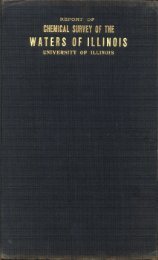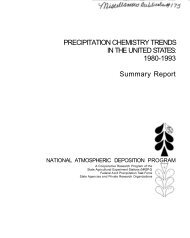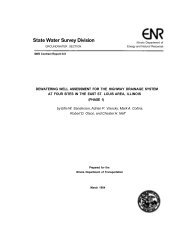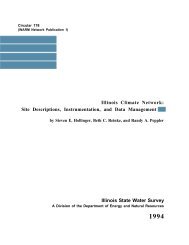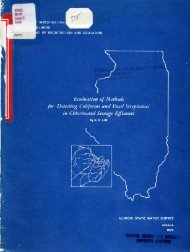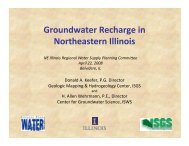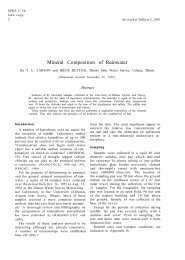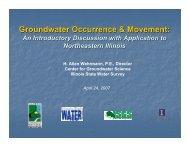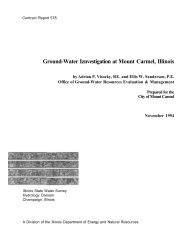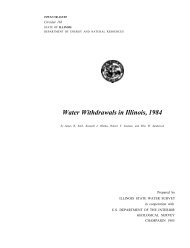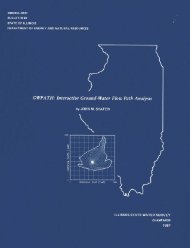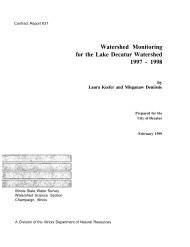Ground-water development in East St. Louis area, Illinois. Urbana, IL ...
Ground-water development in East St. Louis area, Illinois. Urbana, IL ...
Ground-water development in East St. Louis area, Illinois. Urbana, IL ...
You also want an ePaper? Increase the reach of your titles
YUMPU automatically turns print PDFs into web optimized ePapers that Google loves.
CONSTRUCTION FEATURES AND YIELDS OF WELLS<br />
Large capacity wells <strong>in</strong> the <strong>East</strong> <strong>St</strong>. <strong>Louis</strong> <strong>area</strong> are<br />
drilled by the cable tool method, the reverse hydraulic<br />
rotary method, or by clam shell type diggers. Collector<br />
wells have been constructed <strong>in</strong> the <strong>East</strong> <strong>St</strong>. <strong>Louis</strong> <strong>area</strong><br />
by several <strong>in</strong>dustries. Most domestic and some irrigation<br />
wells are driven; a few dug wells are still used for domestic<br />
supplies.<br />
Industrial, municipal, and irrigation wells are usually<br />
drilled to bedrock or bit refusal. Several wells just south<br />
of Alton term<strong>in</strong>ate at the top of clayey and silty material<br />
immediately above bedrock. Accord<strong>in</strong>g to Bergstrom<br />
and Walker (1956) the maximum thickness of the<br />
clayey and silty material is 25 feet. Production wells are<br />
usually cased through the f<strong>in</strong>er alluvial deposits <strong>in</strong> the<br />
upper part of the valley fill and have perforated pipe<br />
sections or commercial screens opposite the lower coarser<br />
alluvium or valley-tra<strong>in</strong> deposits. There are two types<br />
of drilled wells <strong>in</strong> the <strong>area</strong>: natural pack and artificial<br />
pack. Materials surround<strong>in</strong>g the well are developed <strong>in</strong><br />
place <strong>in</strong> the case of the natural pack well; materials hav<strong>in</strong>g<br />
a coarser and more uniform gra<strong>in</strong> size than the natural<br />
formation are added around the well <strong>in</strong> the case of<br />
the artificial pack well. As shown <strong>in</strong> table 18, the thickness<br />
of the pack <strong>in</strong> wells <strong>in</strong> the <strong>area</strong> generally ranges<br />
from 6 to 11 <strong>in</strong>ches.<br />
Depth<br />
(ft)<br />
Table 18.<br />
Cas<strong>in</strong>g<br />
depth<br />
(ft)<br />
Construction Features of Selected Wells<br />
Cas<strong>in</strong>g<br />
diameter<br />
Length<br />
(<strong>in</strong>) (ft)<br />
Diameter<br />
(<strong>in</strong>)<br />
Screen Record<br />
Material<br />
or manufacturer<br />
Slot<br />
number<br />
or size<br />
(<strong>in</strong>)<br />
Artificial<br />
pack<br />
thickness<br />
(<strong>in</strong>)<br />
103 0-73 26<br />
30<br />
26<br />
Everdur<br />
30 11<br />
Johnson<br />
110 0-34 26 76 26 Porous<br />
none<br />
36 36 concrete<br />
85 0-49 30 36 30 Porous<br />
none<br />
40 40 concrete<br />
95 0-47 26 48 26 Porous<br />
none<br />
36 36 concrete<br />
120 0-76 16 44 16 Slotted ¼ X 2½ 9.5<br />
pipe<br />
108 0-73 24 35 24 Everdur 60 6.0<br />
Johnson 100<br />
100 0-63 14 37 12 Slotted ¼ X 2½ 7.0<br />
pipe<br />
105 0-85 12 20 12 Slotted<br />
6.0<br />
pipe<br />
111 0-81 16 30 16 Cook 20<br />
30<br />
114 0-84 16 32 16 Cook 20<br />
40<br />
111 0-81 16 30 16 Cook 20<br />
40<br />
80<br />
98 0-78 18 20 18 Layne 4<br />
Shutter<br />
115 0-85 16 30 16 Cook 30 6.0<br />
105 0-89 10 16 10 Cook none<br />
115 0-100 12 15 12 Johnson 60 none<br />
Several types of well screens have been used <strong>in</strong> the<br />
<strong>East</strong> <strong>St</strong>. <strong>Louis</strong> <strong>area</strong>. Porous concrete, wood, slotted pipe,<br />
and commercial screens are <strong>in</strong> use. Economic considerations<br />
rather than proper well design criteria have governed<br />
the types of screens <strong>in</strong> use. Screen diameters generally<br />
vary <strong>in</strong> diameter from 6 to 30 <strong>in</strong>ches, and screens<br />
vary <strong>in</strong> length from 5 to 76 feet. Screen slot open<strong>in</strong>gs<br />
vary depend<strong>in</strong>g upon the characteristics of the formations<br />
encountered or the characteristics of the artificial<br />
pack.<br />
Ten collector wells have been constructed <strong>in</strong> the <strong>East</strong><br />
<strong>St</strong>. <strong>Louis</strong> <strong>area</strong>, and six are still <strong>in</strong> use. Four collector<br />
wells at the Granite City <strong>St</strong>eel Company were not <strong>in</strong> cont<strong>in</strong>uous<br />
operation <strong>in</strong> 1962, but were tested periodically<br />
and operated occasionally dur<strong>in</strong>g the summer months.<br />
The collector well consists of a large diameter, re<strong>in</strong>forced<br />
concrete caisson from which horizontal screen laterals<br />
project radially near the bottom. The standard caisson<br />
is 13 feet <strong>in</strong> diameter. The horizontal screen laterals are<br />
fabricated from heavy steel plate, perforated with longitud<strong>in</strong>al<br />
slots, and may be 8 to 24 <strong>in</strong>ches <strong>in</strong> diameter and<br />
100 to 450 feet <strong>in</strong> length, depend<strong>in</strong>g upon geologic conditions<br />
and design of the unit (Mikels and Klaer, 1956).<br />
Thorpe concrete wells are <strong>in</strong> wide use by municipalities,<br />
<strong>in</strong>dustries, and irrigation well owners. Thorpe concrete<br />
wells consist of a concrete cas<strong>in</strong>g and porous concrete<br />
screen either 26 or 30 <strong>in</strong>ches <strong>in</strong> <strong>in</strong>side diameter<br />
with walls 5 <strong>in</strong>ches thick. Lengths of screen vary from<br />
24 to 76 feet. Thorpe concrete wells have been <strong>in</strong> operation<br />
for as long as 35 years. However, <strong>in</strong> some cases<br />
Thorpe concrete wells have been abandoned because of<br />
reduction <strong>in</strong> yield after a few months operation.<br />
Driven wells are usually not greater than 50 feet <strong>in</strong><br />
depth depend<strong>in</strong>g upon the thickness of the alluvium overly<strong>in</strong>g<br />
the coarser sand and gravel deposits. The driven<br />
wells consist of lengths of 1.25- or 2-<strong>in</strong>ch diameter pipe<br />
with a drive (or sand) po<strong>in</strong>t at the lower end of the<br />
pipe.<br />
About 500 relief wells were drilled <strong>in</strong> the <strong>East</strong> <strong>St</strong>.<br />
<strong>Louis</strong> <strong>area</strong> by the U.S. Corps of Eng<strong>in</strong>eers near and on<br />
the land side of levees front<strong>in</strong>g the Mississippi River to<br />
control underseepage beneath levees dur<strong>in</strong>g floods. Several<br />
artificial pack relief wells were also drilled along<br />
the Cahokia Diversion Channel. Relief wells <strong>in</strong> the <strong>area</strong><br />
range <strong>in</strong> depth from 47 to 103 feet. Cas<strong>in</strong>gs and screens<br />
are 8 <strong>in</strong>ches <strong>in</strong> diameter and the pack thickness is about<br />
7 <strong>in</strong>ches. The screens are constructed from redwood or<br />
treated Douglas Fir and range <strong>in</strong> length from 19 to 71<br />
feet. The screens are spiral wound with No. 6 gage galvanized<br />
wire and have 18 slots, 3/16 by 3 1/4 <strong>in</strong>ches per<br />
spiral.<br />
Slotted pipe screens are widely used <strong>in</strong> irrigation<br />
wells <strong>in</strong> the <strong>East</strong> <strong>St</strong>. <strong>Louis</strong> <strong>area</strong> because of their low cost.<br />
In comparison, only a few <strong>in</strong>dustrial and municipal<br />
26



